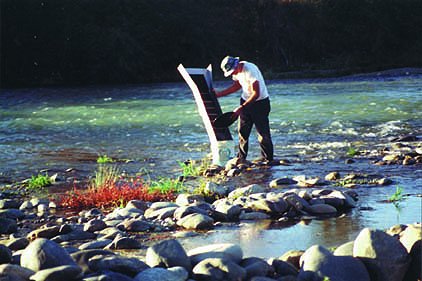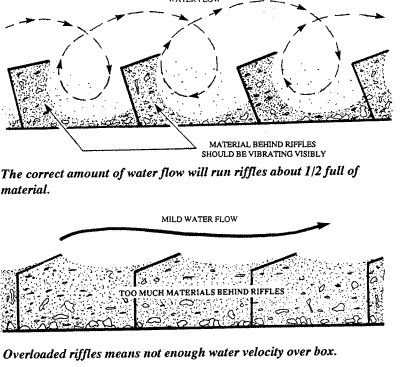By Dave McCracken
The water flow should be just enough to keep the concentrating action going behind each riffle, yet not so much that the riffles are being swept clean.

 As a general rule, the optimum slope-setting of a sluice is around one inch of drop per linear foot of box. This can change, depending upon the volume and velocity of water being used, and/or the average shape, size, volume or weight (specific gravity) of material that you are processing.
As a general rule, the optimum slope-setting of a sluice is around one inch of drop per linear foot of box. This can change, depending upon the volume and velocity of water being used, and/or the average shape, size, volume or weight (specific gravity) of material that you are processing.
There is no exact formula for setting the proper water velocity through a sluice box which will work optimally under all conditions for all the different types of riffles being used today. Therefore, rather than give you a formula, I will attempt to give you an understanding of what affects the proper amount of water velocity will cause in a sluice box, and also what the affects are of too much or too little water velocity. In this way, you will be able to act from direct observation to ensure that your, or anyone else’s, sluicing device will be recovering gold to the fullest extent possible.
In setting up a sluice, if feasible, it is desirable to have enough water flow to move the material through the box as fast as you can shovel (or dredge) it in at full production speed.
Most of the riffles being used today are designed so that a concentrating-action takes place behind the riffles. By increasing or decreasing the amount of water velocity over a set of riffles, the amount of water-action behind each riffle is also increased or decreased—which has an effect on the amount of concentrating action taking place. Water velocity can be increased by either putting more water through the sluice box or by moving the same amount through faster. Optimally, the water flow is just enough to keep the concentrating action going behind each riffle, yet not so much that the riffles are being swept clean (called “boiling”) of their concentrated material.
 How much water velocity is directed over the box directly affects how much material will stay behind the riffles. When the correct amount of water force is being put through a sluice, its riffles will run about half full of material, and the material can be seen to be dancing and vibrating behind the riffles (concentrating) when the water is flowing.
How much water velocity is directed over the box directly affects how much material will stay behind the riffles. When the correct amount of water force is being put through a sluice, its riffles will run about half full of material, and the material can be seen to be dancing and vibrating behind the riffles (concentrating) when the water is flowing.
If too little flow of water is directed through a sluice box, not enough water force can get into the riffles and they will “pack up” with material. In this case, little or no concentrating-action will take place and gold recovery will be poor. When this happens, little or no visible vibrating action behind the riffles will be seen and material will not be moving through the box fast enough to allow you to feed the sluice at production speed without loading up the entire box.
Too much force of water through a sluice box will put too much turbulence behind the riffles. This will cause some of the heavier concentrated material to be swept out of the box.
When this happens, gold recovery will also likely suffer, because the areas located behind the riffles are not calm enough to allow some percentage of the finer pieces of gold to settle. You will notice in this case that the dancing action is occurring behind each riffle, but less material will collect behind the riffles because of the increased amount of turbulence there. When you have too much water velocity, as material is shoveled into the box, it passes through very quickly and has little time to make contact with the riffles.
All the above points remain true when adjusting to get the proper amount of water flowing over an expanded metal-riffle system. However, when using such a system, it is necessary to remember that the riffles are very short. So it does not take very much water velocity to make them concentrate properly.
This means that the size of riffles affect how much water velocity is optimum through the box, how much classification of material is necessary and how fine in size your effective gold recovery will be.
The correct amount of flow is usually found to be just enough to move the material over the box to keep up with your feed of material. Since gold is around 6 times heavier than the average material that will pass through a sluice, there is usually some margin for error if velocity is a little faster than necessary. But a faster flow (than necessary) will affect how fine in size your effective gold recovery will be, if fine gold is present.
Once you have your sluice box set up the way you think it ought to be, it is a good idea to run a sizable portion of gold-bearing material through the box and then pan some samples of the tailings. If you do not find any gold in the tailings, you are set up properly. If you are finding gold in the tailings, some changes are in order. Another test is to mix some pieces of lead in with some material, run it through the sluice, and see where the lead stops.
Sluice boxes process material best when receiving it from a steady feed. Too much material dumped at once into a sluice box has a tendency to overload the riffles and choke off the concentrating-action behind the riffles. This will cause gold to wash right through the sluice box as if there were no riffles present at all.
On the other hand, it is not good practice to run volume-amounts of water flow over a sluice box without some material being constantly or regularly fed through. This is because the scouring-action from the water flows will continue to further-concentrate materials trapped behind the riffles, causing heavier materials to be washed out of the box. A sluice box operated for extended periods with no new material being fed to it has an increased chance of losing some of its fine gold values. How much gold loss will depend on a multitude of factors, such as the type of riffle design, how much water flow, the type and weight of concentrates and the size and purity (specific gravity) of the gold.
So if you will not feed more material into your sluice for a while, it is a good idea to cut your water flow back to reduce turbulence behind the riffles until you are ready to feed again.
Even when a sluice box is set properly, occasional larger-sized stones or rocks can become lodged within the riffles. These should be picked or flipped out of the riffles with minimum disturbance to the remaining portion of the sluice.
On most suction dredges, the volume of water being moved through the sluice continues at the same steady flow during production speed. So adjusting the water velocity to set up the dredge right is accomplished by changing the slope of the sluice box itself—which will speed up or slow down the flow of water over the box. Then, once you are dredging, if you will stop feeding streambed material into the suction nozzle for any period of time, it is wise to block the nozzle with a larger-sized cobble to slow the water flow through your sluice box.
When placing a sluice box within a stream or creek for its water flow, the water velocity can be adjusted by either changing the slope of the box, by varying the volume of water being directed through the box, or by placing the sluice at different sites in the stream or creek where the water is moving at different depths and speeds. Getting the right flow of water to pass through a sluice box out in the field is not difficult. But it is sometimes necessary to try different ideas until you find what works best in each situation. For example, in a location where the water is moving slowly, you might be able to direct more water through the sluice and gain the amount of water velocity that you need. In a stream where the flow is moving more swiftly, the water velocity through your box can usually be adjusted by changing the volume of water directed into it, and/or by varying its downward slope.
Usually, you will have little trouble arriving at the correct velocity through your sluice box when placing it in a fast stream of water. You can use river rocks to make a foundation within the stream so your box can sit level from side to side. By allowing different amounts of water volume through the box, and by changing its downward slope, you can work out a combination that does the job. It is good to have a length of nylon cord along with you for securing the sluice box to a rock or some other object upstream. This prevents the box from being moved off its foundation by the force of water. Sometimes it is necessary to pile a rock or two on top of the box to hold it in place. This is especially true when you are using a sluice made out of wood. You can shovel gravel into the box while trying the different combinations to see what effects the changes have on water velocity.
In a situation where you must set your sluice into slower water, you will find it is generally more difficult to get the flow you need, because you have to create more water velocity than is presently there.
If the flow of the stream itself is not enough to move material through your box, you will sometimes find that changing the slope of the box within the stream has little or no effect on speeding up the flow through the sluice. In this situation, there are several things that might be done to channel enough flow through your box so that you can run material through at production speed. Sometimes the flow of water within the overall stream itself is enough, so that by setting up a “water director” in the stream, you can move enough water through the box to give you the desired result. A water deflector, or barrier, like this can sometimes be built by throwing river rocks out into the stream to make more water flow into and through the sluice.
In this situation, there are several things that might be done to channel enough flow through your box so that you can run material through at production speed. Sometimes the flow of water within the overall stream itself is enough, so that by setting up a “water director” in the stream, you can move enough water through the box to give you the desired result. A water deflector, or barrier, like this can sometimes be built by throwing river rocks out into the stream to make more water flow into and through the sluice.
Sometimes you can get the water velocity needed by arranging a small water-elevator across the waterway. By doing so, and by placing your sluice where the moving water spills over the top, you might create more than enough water flow through the box to meet your needs. It really does not take very much volume of water through a medium-sized sluice box to get the right amount of velocity, if the water is moved through the box at speed. In the case of a short elevator (dam), the water level might only need to be raised up slightly to increase the downward slope of the box enough to create the needed water velocity. How high the elevator needs to be depends mostly upon how much water is flowing within the stream or creek.
A sheet or two of thin plastic, or a plastic tarp, or some old rice bags, can come in handy when you are arranging an elevator or water director within a stream. Such material helps prevent the water from pouring through the holes in your man-made barriers.
A water director or elevator can most often be used with good result wherever the water in a stream or creek is moving and is shallow enough that the barriers can be built easily.
If the water at the work site is moving too slowly, or for some reason a water director or elevator will not work in a particular location, it will be necessary to either set up your sluice in a different location where the water is moving faster, or use a motorized pump to feed water into your sluice. Or, in some situations, it is possible to siphon water into your box from a higher point upstream. Siphoning can be done effectively with the use of reinforced garden hose(es), other types of heavy-walled water hose or PVC.
- Here is where you can buy a sample of natural gold.
- Here is where you can buy Gold Prospecting Equipment & Supplies.
- Books & Videos by Dave McCracken
- Digging for Gold
- Setting up the Proper Recovery System
- Schedule of Events





